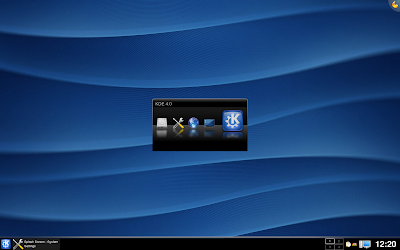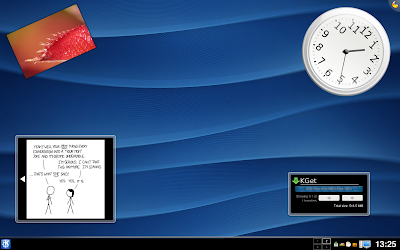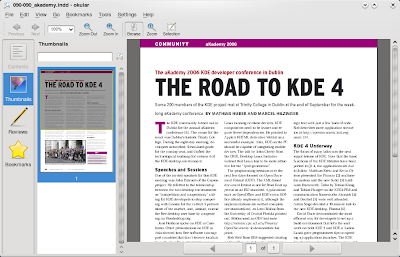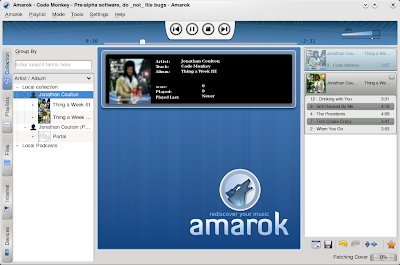One of the exciting new programs introduced in KDE 4.0 is a unified document viewer called Okular.
Based on the solid foundation of KPDF from the KDE3 era, Okular became a document viewer with many more features and support for a large number of formats. At the time I wrote about it in my blog post about KDE4.0.0 it supported 28 file types. In version 0.8.2 (part of KDE 4.2.2) as shipped with Kubuntu Jaunty it supports 45 file types. Note that these numbers may vary greatly with the number of packages supporting various file types installed and that some of the supported types are just compressed versions of others.
Here is what it (a later version: 0.14.1, the screenshots were lost and needed to be re-done) looks like displaying in order: a PDF file, a JPG image, an OpenDocument document and a Comic Book Archive comic.
Additionally Okular supports a presentation mode (not pictured) as well as annotations and reviews:
Okular is slick, powerful and easy to use. It is a great example of the new user interaction ideals seen in all components of KDE 4.
Showing posts with label KDE4. Show all posts
Showing posts with label KDE4. Show all posts
20080214
Integrating GTK apps with the KDE4 desktop with gtk-qt for Qt4 (screenshots)
For KDE3 David Sansome wrote a special GTK theme gtk-qt, which instead of drawing its own representation of buttons and other user interface elements, called the corresponding Qt3 drawing functions. Believe me, this sounds a lot more trivial than it is.
When it was done, it showed some very impressive results.
 Image courtesy of David Sansome
Image courtesy of David Sansome
However, after KDE4 was released (my review), Qt3 started to look equally out of place as gtk rather quickly, when the Oxygen widget style manifested itself as the default KDE4 look:


When Firefox 3 beta 3 was released the other day I tried to get a glimpse of the new gtk widget integration. Suffice it to say: It looked really strange and not like something they would have bragged about.

It's obviously KDE3 showing here. So I decided to see if there was a KDE4 version of gtk-qt. It turns out there isn't. But I found this bug report and a reply by David Sansome himself, stating that:
He has created a branch in the development repository, which I have checked out. Screnshots incoming!
Keep in mind: THIS IS NOT A RELEASE! But very much a work in progress. If there are problems, they will be ironed out!
The first impression is that it looks very impressive!


The not quite so straight-forward firefox interface reveals some drawing issue though:

But they are IMHO a lot better to look at than the qt3 version, which just looks thoroughly out of place:

There are also issues with widgets embedded into web pages, which disappear on a re-draw (for example scrolling page-wise, not progressively).


Compare with the same piece rendered by Konqueror:

Overall the port seems to be progressing well (the repository is seeing frequent commits) and I look forward to GTK apps integrating more smoothly with the KDE4 desktop.
Update: I have made a mistake attributing the brokenness we saw with the current firefox beta to gtkqt. Instead it appears the feature was not working quite correctly in firefox itself. I noticed a couple of days after this post was published that the same drawing weirdness we saw in the screenshot also appears on a pure gnome system. I can't reproduce it now and as matter of fact the current ubuntu packages on hardy make firefox fit in nicely.
Sorry about this mis-information. It seems gtkqt4 is in even better shape than I originally thought.
When it was done, it showed some very impressive results.
 Image courtesy of David Sansome
Image courtesy of David SansomeHowever, after KDE4 was released (my review), Qt3 started to look equally out of place as gtk rather quickly, when the Oxygen widget style manifested itself as the default KDE4 look:


When Firefox 3 beta 3 was released the other day I tried to get a glimpse of the new gtk widget integration. Suffice it to say: It looked really strange and not like something they would have bragged about.

It's obviously KDE3 showing here. So I decided to see if there was a KDE4 version of gtk-qt. It turns out there isn't. But I found this bug report and a reply by David Sansome himself, stating that:
Just wanted to let you know that I *am* working on this, but as previous posters have said Qt4 has changed a lot in the theming department and it's not as simple as just porting the old code over.
He has created a branch in the development repository, which I have checked out. Screnshots incoming!
Keep in mind: THIS IS NOT A RELEASE! But very much a work in progress. If there are problems, they will be ironed out!
The first impression is that it looks very impressive!


The not quite so straight-forward firefox interface reveals some drawing issue though:

But they are IMHO a lot better to look at than the qt3 version, which just looks thoroughly out of place:

There are also issues with widgets embedded into web pages, which disappear on a re-draw (for example scrolling page-wise, not progressively).


Compare with the same piece rendered by Konqueror:

Overall the port seems to be progressing well (the repository is seeing frequent commits) and I look forward to GTK apps integrating more smoothly with the KDE4 desktop.
Update: I have made a mistake attributing the brokenness we saw with the current firefox beta to gtkqt. Instead it appears the feature was not working quite correctly in firefox itself. I noticed a couple of days after this post was published that the same drawing weirdness we saw in the screenshot also appears on a pure gnome system. I can't reproduce it now and as matter of fact the current ubuntu packages on hardy make firefox fit in nicely.
Sorry about this mis-information. It seems gtkqt4 is in even better shape than I originally thought.
20080106
First look at the unreleased KDE4.0.0 (with screenshots)
KDE 4.0.0 is days away from being released. In this post I show you some pieces of the final look of KDE4.0.0 and mention some of the most anticipated features of this great step forward for the Free software desktop. Let's take a look at the final state of this highly anticipated release.
While some of the most shift-key-challenged KDE personalities have cautioned against too high hopes for KDE4.0.0 and despite it being the very first in a long row of releases: KDE4.0.0 is a very impressive desktop.
As the version number suggests KDE4.0.0 is the very first release since KDE3.0.0 to break binary compatibility with KDE3. Being allowed to burn some bridges is the reason so many new frameworks and large changes have landed in just one release.
Starting up
I have been following the development of KDE4 for quite a few months now. The version I base this post on is from the main KDE development (trunk in svn) at the time of the release tagging freeze. As such it should be very similar to the packages you will receive from your favorite distribution on the 11th.
Progress all around
Many of the new frameworks are still almost unused in the user interface of the first KDE4 release. But some more obvious and easily implementable changes have already appeared in KDE4.0.0.
Graphics
Oxygen: Originally planned as the new icon set for KDE4, Oxygen has re-defined all aspects of KDE's user interface, including the window decorations and theme.
Plasma: Plasma is the new desktop shell of KDE4, one of the most anticipated components of KDE4 and the one which was started last.
Because of its late start plasma has not realized its full potential yet, but as with many things in KDE4.0.0 it will gain features rapidly in the future. Plasma's vision is a lot more than to display a panel and cool looking widgets. Stay tuned, already KDE4.1 will introduce new features.
KWin: KWin has been a very robust window manager for a long time. New in KDE4 is its ability to use desktop effects, window shadows and subtle animations. These features depend on the availability of OpenGL or at least XRender, which are not fully supported on all graphics cards yet although the situation is improving rapidly.
However to reduce the risk of an unusable interface, desktop effects may be disabled by default in KDE4.0.0. They can be easily enabled in Systemsettings (KDE4's control center replacement) under Desktop -> Desktop Effects.
Applications
Dolphin: The new default file manager in KDE4. While Konqueror has retained its ability to manage files (and cook coffee) dolphin is written specifically for this task.
The first visible piece of KDE4's new semantic search backend Nepomuk (the name won't be visible in the UI) is dolphin's ability to annotate and rate files.
In the future Nepomuk and Strigi will help you answer questions like "Who gave me this file?" or "What sources did I use on that KDE4.0.0 blog post?"
Progress in Qt4 (the toolkit KDE4 is based on) allows user interface polish like dolphin's sidebar, which changes its layout dynamically as the user drags it. No screenshot, you have to see this one in action.
Gwenview: KDE's image viewer Gwenview has received a lot of polish while it was ported to KDE4 and handles really, really well.
Okular: The new document viewer for KDE4, based on KDE3's KPDF application. It sports annotation features, previews, presentation mode, bookmarks and support for no less than 28 file types in my build.
Unreleased Applications
Amarok: The famous KDE based audio player has been ported to KDE4 and is receiving a major overhaul. It is currently in pre-alpha state, but I have been able to use it normally over the last few weeks. When it is ready, it may also be released for windows.
Dragon Player: Based on the Codein video player from the KDE3 days, Dragon Player continues a successful carrier as a simple and enjoybale video player.
These are some of the highlights of the upcoming KDE4.0.0. I hope you enjoyed this preview and have come to share my opinion that KDE4 is going to rock!
Take a look at this album for these and a few more screenshots I didn't include in this post. If you would like me to screenshot another application for you let me know in the comments and I will add it.
Labels:
KDE,
KDE4,
KDE4.0.0,
review,
screenies,
screenshots,
unreleased
Subscribe to:
Posts (Atom)













